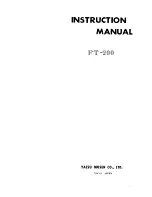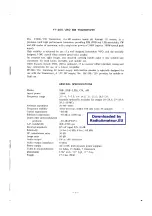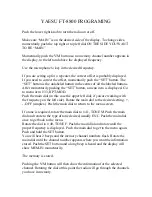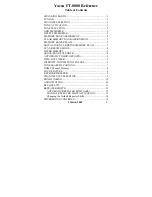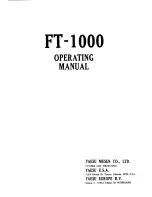
Permissible Battery Voltage Ripple ........................................................
7-'h%
Ambient Temperature Range .................................................................. - 20o
c
to
+
550
c.
Receiver Maximum Sensitivity ............................................................... . 025 volts for 10 rna.
output.
Receiver Selectivity ............................................................................ See Fig. 12
Receiver Signal-to-Noise Ratio Requirements ........ ................... ................ 12-db
Minimum Channel Spacing . . .. .. .. . .. .. . . .. . . .. . .. . . .. .. .. .. .. .. . .. .. . .. .. .. .. . .. .. .. .. .. . . .. .. See Fig. 14
Power Input ....................................................................................... 115-ma at 48 VDC, 20o-ma
at 125 VDC, 1.28 amperes
at 250 VDC.
Carrier On- Off Keying .. .. .. .. .. .. .. .. .. .. .. .. .. .. .. .. .. .. .. .. .. .. .. .. .. .. .. .. .. .... .. .. ...... . Requires one pair of con
tacts capable of keying 8-ma
DC at an open c ircuit voltage
of 125 VDC.
Weight (With Flexitest Case) ................................................................. Appr oximately 16-lbs.
C AUTI O N
Refer application to Westinghouse when
other transmitters are to be connected to the same
coax cable as certain conditions may result in damage
to the output transistors.
D E S C R I PT I O N
Mechanical
This apparatus is supplied in a Flexitest case
and may be either flush or projection mounted in
order to match other switchboar d equipment. The out
line dimensions and also the drilling plan for flush
an:d projection mounting are shown by Fig. 1. The
majority of the par ts ar e mounted on a pr inted circuit
board. This board may be readily removed as follows:
1. Remove the two output plugs from the red and
black jacks.
2. Disconnect the receiver input coaxial cable
connector.
3. Loosen the two screws at the top of the board.
4. Loosen the two screws at the bottom of the
board and pull them out as far as they will extend.
5. Pull board down to disengage the terminals
and lift out.
The transmitter output filter may be removed by
removing four mounting screws from the bottom of the
case and disconnecting the coaxial cable.
Fig.
6.
shows the location of major components
such as potentiometers, jack, test points, crystals,
transistors,
etc. External connections and
the
Schematic Diagram are shown by Fig. 2. The num
bered terminals shown as squares apply to the ex
ternal terminals.
Pr ovisions are- made for plugging the Voice
Adapter Unit in the r ear of the relaying equipment.
Octal socket mar ked X-4 on t he r ear of the set
accommodates the adapter plug. A buckle type strap
on each side of t he adapter holds the unit in place
after it has been plugged in. The normal projection
for a rear mounted Voice Adapter is 3-inches be
yond that of the relaying equipment. When the KR
Relaying Unit is supplied with the adapter, a patch
cord is available on separ ate order. This patch cord
plugs into the telephone jacks on the adapter and pro
vides an extension to a conveniently located terminal
board.
The panel cutout information necessar y for mount
ing the Reserve Signal Detector is shown by Fig. 11.
This unit consists of a potentiometer and pushbutton
switch mounted on a small panel, itself suitable for
switchboard mounting.
For 250-volt operation, separate auxiliar y resis
tors are required, as shown in Fig. 8.
El ectrical
Transmitter
The transmitter is made of four main stages in -
3
www
. ElectricalPartManuals
. com
Summary of Contents for Type KR
Page 38: ...w w w E l e c t r i c a l P a r t M a n u a l s c o m...
Page 39: ...w w w E l e c t r i c a l P a r t M a n u a l s c o m...
Page 118: ...TYPE K R CARRI E R SET w w w E l e c t r i c a l P a r t M a n u a l s c o m...
Page 123: ...w w w E l e c t r i c a l P a r t M a n u a l s c o m...























